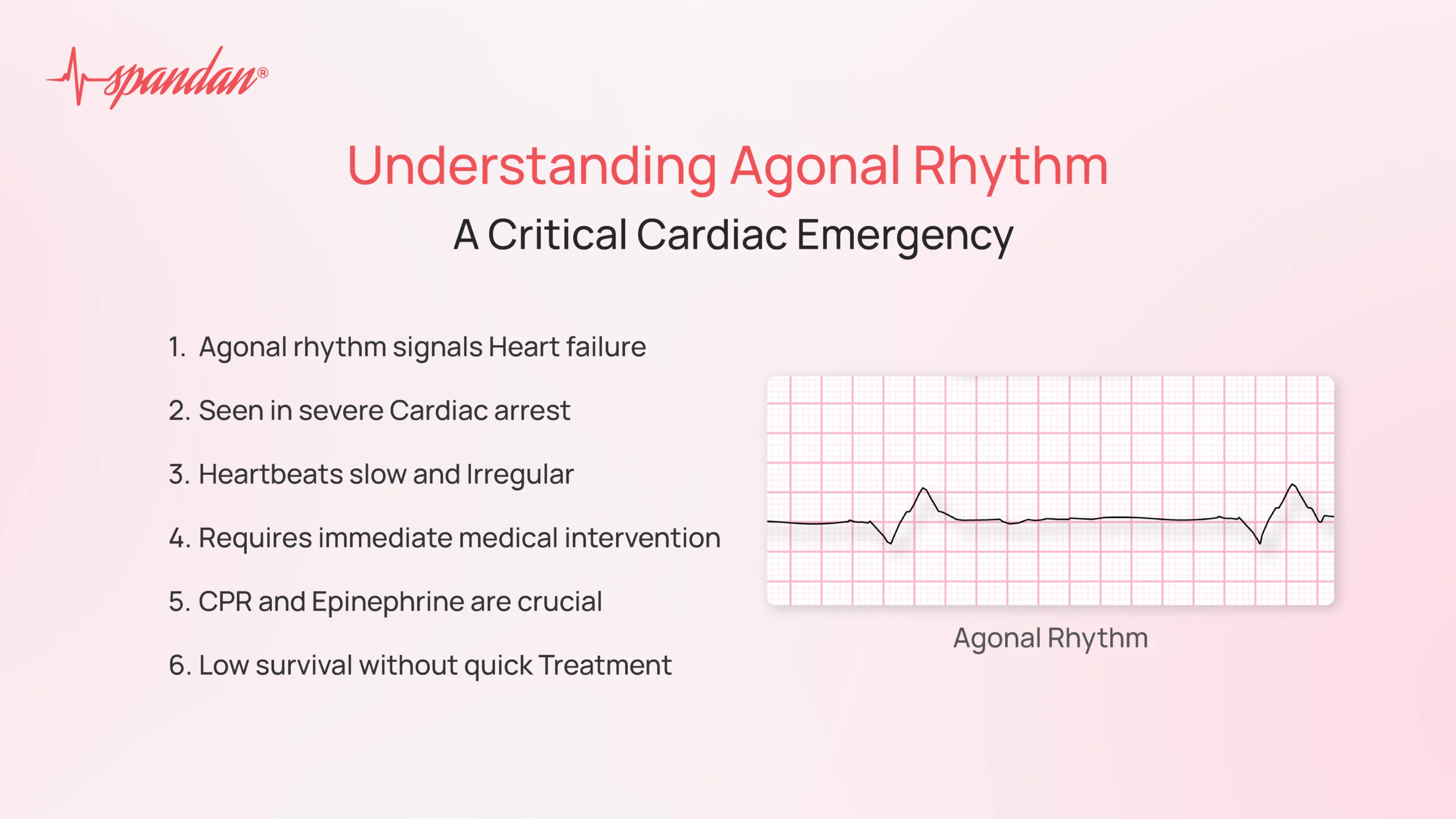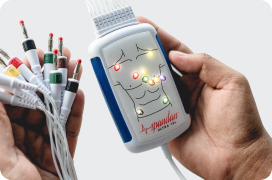
Related Article
Author:- Mr. Ritesh Sharma
Table of Contents
Agonal rhythm is a critical and often dire medical condition that occurs during severe cardiac distress. This abnormal heart rhythm, typically associated with the final stages of life or cardiac arrest, is characterized by slow, irregular electrical activity that lacks the coordination needed for effective heartbeats. Recognizing and understanding agonal rhythm is crucial for healthcare providers as it represents a last, albeit faint, opportunity for intervention before death occurs. In this blog, we will explore what agonal rhythm is, its causes, how it presents clinically, and what can be done when it is detected.
What is Agonal Rhythm?
Agonal rhythm is an abnormal heart rhythm that is often seen in the late stages of cardiac arrest or severe cardiovascular compromise. It is typically characterized by an extremely slow heart rate and irregular, uncoordinated electrical activity in the heart. In most cases, agonal rhythm indicates that the heart is struggling to function, and it often precedes complete cessation of electrical activity, otherwise known as asystole. This rhythm is frequently a sign of impending death if immediate medical intervention is not provided.
The term “agonal” comes from the word “agony,” reflecting the critical and life-threatening nature of this rhythm. It is often referred to as a “dying heart rhythm” because it occurs when the heart is no longer capable of effectively pumping blood throughout the body, leading to severe oxygen deprivation in the tissues and vital organs.
Causes of Agonal Rhythm
Agonal rhythm is most commonly seen during the final stages of a heart attack, also known as myocardial infarction, or during a prolonged cardiac arrest. However, several factors can lead to the development of this rhythm, including:
- Severe Hypoxia: When the body is deprived of oxygen for an extended period, the heart’s ability to contract efficiently deteriorates, leading to agonal rhythm.
- Cardiac Arrest: As the heart goes into cardiac arrest, the electrical activity becomes disorganized. Agonal rhythm may appear as the heart struggles before reaching asystole.
- Massive Trauma or Blood Loss: Trauma that results in massive blood loss can lead to severe hypovolemia (loss of blood volume), causing inadequate perfusion to the heart, which in turn can result in agonal rhythm.
- Drug Overdose: Overdoses of certain drugs, particularly opioids or sedatives, can depress the central nervous system and cause a severe slowing of the heart rate, leading to rhythm.
- Severe Electrolyte Imbalance: Critical imbalances in electrolytes, such as potassium and calcium, can disrupt the normal electrical activity of the heart, leading to rhythm.
Clinical Presentation of Agonal Rhythm
Recognizing agonal rhythm is crucial for medical professionals as it requires immediate action. It can be identified on an electrocardiogram (ECG) as a slow and disorganized rhythm, usually at a rate of fewer than 20 beats per minute. The QRS complexes (the part of the ECG that represents ventricular depolarization) are typically wide and irregular. P-waves, which represent atrial depolarization, may or may not be present, and if they are, they are usually not conducted properly to the ventricles.
Patients in agonal rhythm often present with no palpable pulse, as the heart is not contracting forcefully enough to create an effective circulation of blood. They may be unconscious and unresponsive, with shallow, irregular, or gasping breaths, known as agonal respirations. These breaths are often mistaken for signs of life, but they are actually a reflex response to the brain’s lack of oxygen.
Agonal Rhythm vs. Other Rhythms
It is important to differentiate agonal rhythm from other types of cardiac rhythms seen during cardiac arrest, such as pulseless electrical activity (PEA) and asystole. In pulseless electrical activity, there is organized electrical activity in the heart, but no pulse is present. Asystole, on the other hand, represents a complete cessation of electrical activity and is characterized by a flat line on the ECG. Agonal rhythm falls somewhere between these two; there is still electrical activity, but it is so slow and disorganized that it cannot sustain life.
Treatment of Agonal Rhythm
Agonal rhythm is a medical emergency, and immediate intervention is required to prevent death. Treatment typically focuses on restoring effective cardiac function through advanced cardiovascular life support (ACLS) protocols.
- CPR: Cardiopulmonary resuscitation (CPR) should be initiated immediately to maintain circulation and oxygen delivery to vital organs. High-quality chest compressions are crucial in keeping blood flowing until more definitive treatment can be provided.
- Defibrillation: If agonal rhythm is preceded by ventricular fibrillation (VF) or ventricular tachycardia (VT), defibrillation should be attempted. However, rhythm itself is generally not responsive to defibrillation since it is not a shockable rhythm.
- Epinephrine: Epinephrine is often administered to stimulate the heart and increase the likelihood of converting agonal rhythm into a more organized rhythm that can sustain life. It works by increasing blood flow to the heart and brain and promoting return of spontaneous circulation (ROSC).
- Advanced Airway Management: Ensuring that the patient is receiving adequate oxygen is critical. If agonal respirations are present, securing an airway through intubation or other advanced techniques may be necessary to provide controlled ventilation.
- Identifying and Treating Underlying Causes: As with any cardiac arrest, identifying the reversible causes of agonal rhythm is key to successful resuscitation. The common reversible causes (the “Hs and Ts” of cardiac arrest) include hypoxia, hypovolemia, hydrogen ion (acidosis), hypo/hyperkalemia, hypothermia, toxins, tamponade, tension pneumothorax, thrombosis (coronary and pulmonary), and trauma. Treating these underlying conditions can improve the chances of survival.
Prognosis and Outcome
The prognosis for individuals experiencing agonal rhythm is generally poor, as it typically occurs in the context of severe or prolonged cardiac arrest. Without immediate and effective intervention, this rhythm will progress to asystole, and death will follow. Even with prompt medical treatment, the survival rate is low, particularly if the rhythm is not detected and treated in time. However, successful resuscitation is possible in some cases, especially if the underlying cause of the this rhythm can be quickly identified and corrected.
Agonal rhythm is a critical cardiac event that represents the heart’s last efforts to maintain some level of function in the face of severe distress or failure. It is commonly seen in patients experiencing cardiac arrest, and it signals an urgent need for intervention. Understanding agonal rhythm, its causes, and the appropriate treatments can mean the difference between life and death in emergency situations. While the prognosis is often grim, timely resuscitation efforts can sometimes result in a positive outcome, making it essential for healthcare providers to act swiftly when this rhythm is identified.




